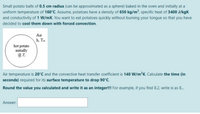
Elements Of Electromagnetics
7th Edition
ISBN: 9780190698614
Author: Sadiku, Matthew N. O.
Publisher: Oxford University Press
expand_more
expand_more
format_list_bulleted
Question

Transcribed Image Text:Small potato balls of 0.5 cm radius (can be approximated as a sphere) baked in the oven and initially at a
uniform temperature of 160°C. Assume, potatoes have a density of 650 kg/m³, specific heat of 3400 J/kgK
and conductivity of 1 W/mK. You want to eat potatoes quickly without burning your tongue so that you have
decided to cool them down with forced convection.
Air
h, T.
hot potato
initially
Air temperature is 20'C and the convective heat transfer coefficient is 140 W/m²K. Calculate the time (in
seconds) required for its surface temperature to drop 90°C.
Round the value you calculated and write it as an integer!! For example, if you find 8.2, write is as 8.
Answer:
Expert Solution
This question has been solved!
Explore an expertly crafted, step-by-step solution for a thorough understanding of key concepts.
This is a popular solution
Trending nowThis is a popular solution!
Step by stepSolved in 2 steps

Knowledge Booster
Learn more about
Need a deep-dive on the concept behind this application? Look no further. Learn more about this topic, mechanical-engineering and related others by exploring similar questions and additional content below.Similar questions
- Note:- • Do not provide handwritten solution. Maintain accuracy and quality in your answer. Take care of plagiarism. • Answer completely. • You will get up vote for sure.arrow_forwardA food product with 73% moisture content in a 7 cm diameter can wants to be frozen. The density of the product is 970 kg / m³, the thermal conductivity is 1.2 W / (m K), and the initial freezing temperature is -2 ° C. After 11 hours in the freezing medium -30 ° C, the product temperature becomes -10 ° C. Estimate the convection heat transfer coefficient of the freezing medium. Assume the can as an infinite cylinder. h = W / (m² K).arrow_forwardThe thermal boundary layer in heat transfer exists whenever there is a difference between the temperatures of the fluid and the outside environment. For fluid flow, how does a boundary layer form?A. Because common surfaces are not smooth, the flow is hindered, and boundary layers are formed.B. The disturbances on the streamlines in high Reynolds number flow produces boundary layer.C. The existence of walls or “boundaries” that keep the fluid inside (or outside) creates the boundary layer.D. Velocity profiles are inherently approaching no-slip condition because of the resistance of the walls.arrow_forward
- Small potato balls of 0.5 cm radius (can be approximated as a sphere) baked in the oven and initially at a uniform temperature of 160°C. Assume, potatoes have a density of 650 kg/m, specific heat of 3400 J/kgK and conductivity of 1 W/mK. You want to eat potatoes quickly without burning your tongue so that you have decided to cool them down with forced convection. Air h, T. hot potato initially Air temperature is 20°C and the convective heat transfer coefficient is 140 W/m?K. Calculate the time (in seconds) required for its surface temperature to drop 90°C.arrow_forwardHello Sir,Good Evening. I have a question in my homework related Heat Transfer lesson. The following below is my question. Please Advice. Thank You "In the concept of convection heat transfer, the value of the convection coefficient (ℎ) is highly dependent on the flow velocity. Based on the concept (give a brief explanation)1. Which is more effective in transferring heat by natural convection or forced convection?2. How to explain the relationship between flow velocity and convection coefficient (ℎ) ?"arrow_forward2-D: A fin may be manufactured as an integral part of a surface by using a casting or extrusion process, or it may be separately brazed or adhered to the surface. From thermal considerations, which option is preferred? 2-E: What is the difference between steady-state and transient heat transfer processes? Give an example for each of them. 2-F: What is the physical interpretation of the Biot number? 2-G: For flow over a flat plate, sketch variation of local convective heat transfer coefficient, h(x), versus the distance along the plate x for laminar, transition, and turbulent flow regimes.arrow_forward
arrow_back_ios
arrow_forward_ios
Recommended textbooks for you
 Elements Of ElectromagneticsMechanical EngineeringISBN:9780190698614Author:Sadiku, Matthew N. O.Publisher:Oxford University Press
Elements Of ElectromagneticsMechanical EngineeringISBN:9780190698614Author:Sadiku, Matthew N. O.Publisher:Oxford University Press Mechanics of Materials (10th Edition)Mechanical EngineeringISBN:9780134319650Author:Russell C. HibbelerPublisher:PEARSON
Mechanics of Materials (10th Edition)Mechanical EngineeringISBN:9780134319650Author:Russell C. HibbelerPublisher:PEARSON Thermodynamics: An Engineering ApproachMechanical EngineeringISBN:9781259822674Author:Yunus A. Cengel Dr., Michael A. BolesPublisher:McGraw-Hill Education
Thermodynamics: An Engineering ApproachMechanical EngineeringISBN:9781259822674Author:Yunus A. Cengel Dr., Michael A. BolesPublisher:McGraw-Hill Education Control Systems EngineeringMechanical EngineeringISBN:9781118170519Author:Norman S. NisePublisher:WILEY
Control Systems EngineeringMechanical EngineeringISBN:9781118170519Author:Norman S. NisePublisher:WILEY Mechanics of Materials (MindTap Course List)Mechanical EngineeringISBN:9781337093347Author:Barry J. Goodno, James M. GerePublisher:Cengage Learning
Mechanics of Materials (MindTap Course List)Mechanical EngineeringISBN:9781337093347Author:Barry J. Goodno, James M. GerePublisher:Cengage Learning Engineering Mechanics: StaticsMechanical EngineeringISBN:9781118807330Author:James L. Meriam, L. G. Kraige, J. N. BoltonPublisher:WILEY
Engineering Mechanics: StaticsMechanical EngineeringISBN:9781118807330Author:James L. Meriam, L. G. Kraige, J. N. BoltonPublisher:WILEY

Elements Of Electromagnetics
Mechanical Engineering
ISBN:9780190698614
Author:Sadiku, Matthew N. O.
Publisher:Oxford University Press

Mechanics of Materials (10th Edition)
Mechanical Engineering
ISBN:9780134319650
Author:Russell C. Hibbeler
Publisher:PEARSON

Thermodynamics: An Engineering Approach
Mechanical Engineering
ISBN:9781259822674
Author:Yunus A. Cengel Dr., Michael A. Boles
Publisher:McGraw-Hill Education

Control Systems Engineering
Mechanical Engineering
ISBN:9781118170519
Author:Norman S. Nise
Publisher:WILEY

Mechanics of Materials (MindTap Course List)
Mechanical Engineering
ISBN:9781337093347
Author:Barry J. Goodno, James M. Gere
Publisher:Cengage Learning

Engineering Mechanics: Statics
Mechanical Engineering
ISBN:9781118807330
Author:James L. Meriam, L. G. Kraige, J. N. Bolton
Publisher:WILEY